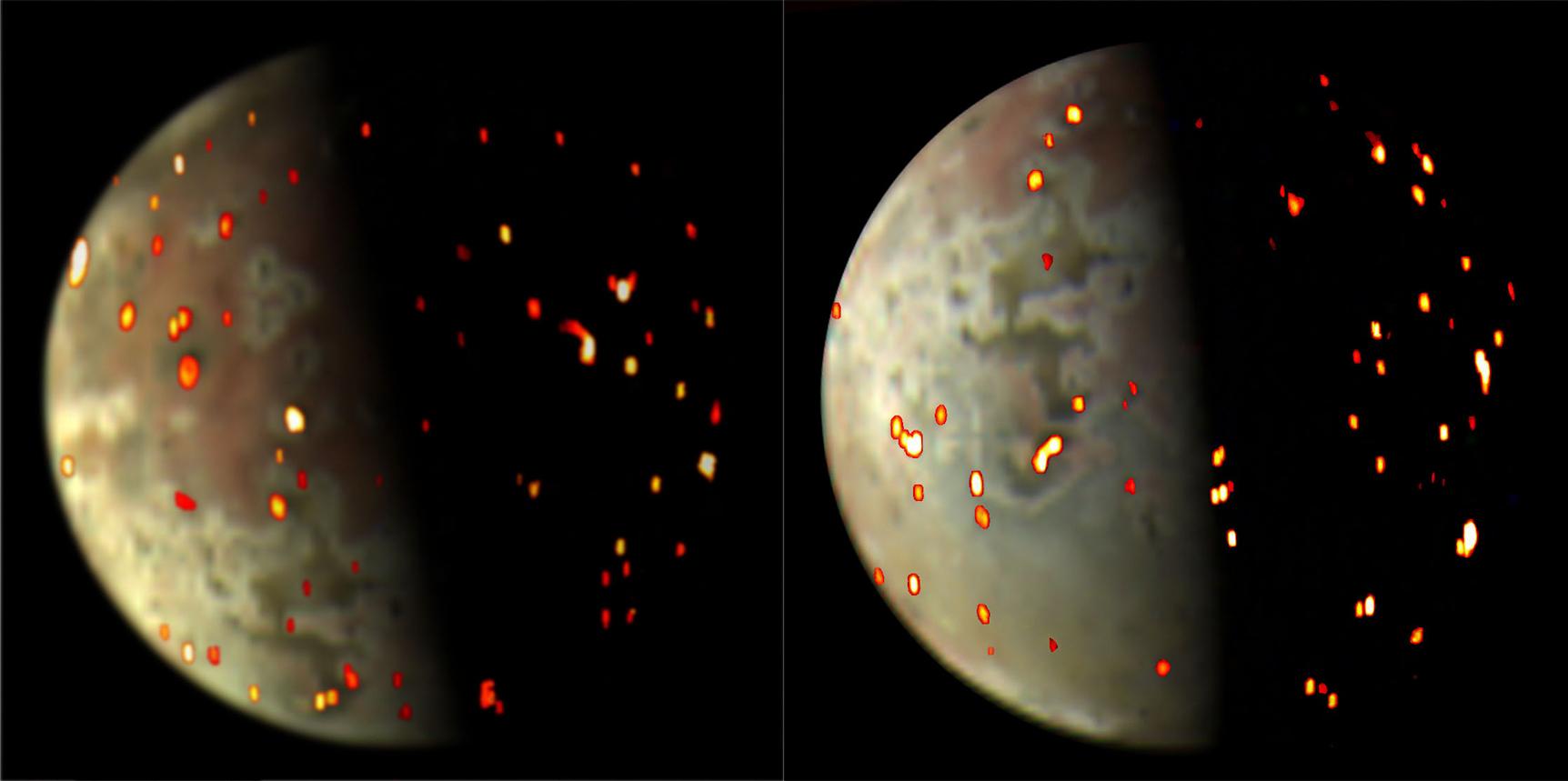NASA's Juno Jupiter probe to get closest view of volcanic moon Io on July 30
The solar-powered spacecraft will make its 52nd flyby of Io this weekend, taking its closest-ever look at the volcanic moon.

NASA's Juno spacecraft will get closer than ever before to Jupiter’s fiery moon, Io, this weekend.
On Sunday (July 30), the solar-powered mission will come within 13,700 miles (22,000 km) of Io's volcanic surface. This Jovian satellite is just slightly larger than Earth’s moon, making it the fourth largest moon in our solar system.
As it makes its flyby, Juno will use its scientific instruments to collect data about hundreds of eruptions taking place across the 2,260-mile (3,640 km) moon. One instrument in particular will get to shine during the event: The Jovian InfraRed Auroral Mapper (JIRAM).
"While JIRAM was designed to look at Jupiter’s polar aurora, its capability to identify heat sources is proving to be indispensable in our hunt for active volcanos on Io," Juno Principal Investigator, Scott Bolton, said in a statement. "As we get closer with each flyby, JIRAM and other instruments aboard Juno add to our library of data on the moon, allowing us to not only better resolve surface features but understand how they change over time."
Related: See Jupiter’s volcanic moon Io glow red-hot in incredible images from NASA’s Juno probe
After its launch in 2011, the Juno probe arrived at the Jovian system in 2016 and has since been investigating Jupiter and its moons. The day after Sunday's close fly-by of Io will be an important one for Juno, too, as Monday (July 31) will mark the beginning of its third year of extended operations.
How Jupiter turns Io into a fiery stress toy
Io’s volcanism comes from the somewhat torturous relationship it has with Jupiter, largest planet in our solar system. The gas giant's tremendous gravitational influence pulls on Io, and as it does this, the moon is also gravitationally tugged on by its fellow Jovian moons Europa — the solar system’s largest moon — and Ganymede.
Breaking space news, the latest updates on rocket launches, skywatching events and more!
This cosmic tug of war gives rise to incredible tidal forces on the moon, stretching and squeezing Io while causing its surface to undulate in and out, resulting in uneven ground that can vary in height by as much as 330 feet (100 m).
The effect of turning Io into a planetary stress toy gives rise to extreme volcanism, which makes the moon the most volcanically active body in the solar system. Lava from Io's volcanoes can erupt dozens of miles (or km) upward, according to NASA.
JIRAM and Juno's other instruments are no strangers to Io's fiery temper. Even before the last flyby of the volcanic moon on May 16, JIRAM, for instance, had been able to see hot spots across the Jovian satellite.
Also during this pass, another instrument on the spacecraft, JunoCam, snapped an image of Io from 22,100 miles (35,600 km) away which showed a smudge in a region near the equator called Volund. While "smudges" might not sound too exciting, to planetary scientists, they are smoking guns for volcanic activity.
"When I compared it to visible-light images taken of the same area during Galileo and New Horizons flybys (in 1999 and 2007), I was excited to see changes at Volund, where the lava flow field had expanded to the west and another volcano just north of Volund had fresh lava flows surrounding it," University of Arizona researcher, Jason Perry, said. "Io is known for its extreme volcanic activity, but after 16 years, it is so nice to see these changes up close again."

But that wasn't the only smoking gun spotted during this flyby. JIRAM also caught one of its own.
Imaging the 125-mile (202-km) wide volcanic depression, known as the Loki Patera, JIRAM had managed to catch a glimpse of what appears to be an active volcano. The Juno team hopes to actually get another look at this potential volcano, though this time in more detail, as Io makes its super close flyby of Io over the weekend.
"The data show the lava could be bubbling to the surface in the northwest portion and creating a lava lake to the south and east," Juno co-investigator from the National Institute for Astrophysics in Rome, Alessandro Mura, said. "Any volcanologist will tell you it is important to determine whether a lava lake has a stable source of material from an underground chamber. These data, and those we collect on upcoming flybys, will be crucial to understanding the kind of volcanism that is occurring at Io."
Speaking before Juno's last flyby of Io, which brought the craft to within 22,060 miles (35,500 km) of the Jovian moon’s surface, the mission's principal investigator Scott Bolton explained why the investigation of the volcanic body is heating up.
"Io is the most volcanic celestial body that we know of in our solar system," Bolton said in a statement. "By observing it over time on multiple passes, we can watch how the volcanoes vary — how often they erupt, how bright and hot they are, whether they are linked to a group or solo, and if the shape of the lava flow changes."

Robert Lea is a science journalist in the U.K. whose articles have been published in Physics World, New Scientist, Astronomy Magazine, All About Space, Newsweek and ZME Science. He also writes about science communication for Elsevier and the European Journal of Physics. Rob holds a bachelor of science degree in physics and astronomy from the U.K.’s Open University. Follow him on Twitter @sciencef1rst.

